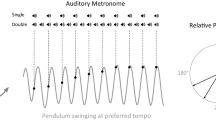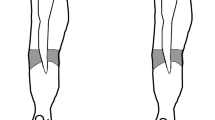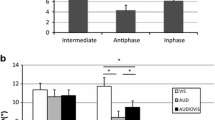Abstract
Rhythmical movements are well-known to exhibit spontaneous and well-defined relationships between frequency and amplitude (preferred behavior). However, if required, these relationships can be modified (constrained behavior). This flexibility constitutes a fundamental basis for adapting motor functions to the subject’s intentions in a given environment. In order to assess the role of proprioceptive information in the stabilization of preferred versus constrained rhythmical movements, we compared both cases in a deafferented patient and in a control group. Initially, the subjects were given as much time as they needed to adopt different, steady rhythmical movements in the presence of external feedback. Afterwards, the feedback was suppressed and the subjects had to maintain the same oscillating regimes for one additional minute. In the absence of feedback, the deafferented patient was able to stabilize the timing of both the preferred and the constrained movements. The spatial properties remained stationary for the preferred movements; however, large effects were observed in the constrained movements. By contrast, the control subjects were able to keep both the preferred and the constrained behaviors stationary. Our results show that, when reaching preferred regimes, the behavior remains stationary even in the absence of proprioceptive information. By contrast, proprioceptive feedbacks were shown to be necessary in order to maintain non-preferred regimes. In this case, error-correction mechanisms based on proprioceptive information allows for compensation of the natural tendency of the system to return to its preferred behavior.
Similar content being viewed by others
Author information
Authors and Affiliations
Additional information
Received: 10 August 1998 / Accepted: 18 May 1999
Rights and permissions
About this article
Cite this article
Bonnard, M., Pailhous, J. Contribution of proprioceptive information to preferred versus constrained space-time behavior in rhythmical movements. Exp Brain Res 128, 568–572 (1999). https://doi.org/10.1007/s002210050883
Issue Date:
DOI: https://doi.org/10.1007/s002210050883




